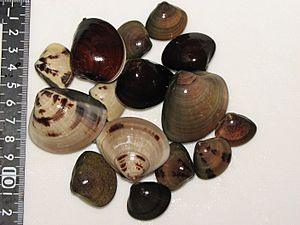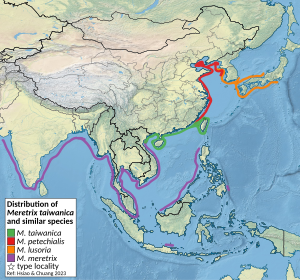Hamaguri facts for kids
Quick facts for kids Hamaguri |
|
|---|---|
 |
|
| Scientific classification | |
| Genus: |
Meretrix
|
| Species: |
lusoria
|
The hamaguri clam, also known as the Asian hard clam or common Orient clam, is a type of saltwater clam. It's a marine bivalve mollusk, which means it's a sea creature with two shells that are hinged together. This clam belongs to the family called Veneridae, often known as Venus clams.
This clam originally comes from the waters around Japan. People use it for food, especially in sushi. Its beautiful white shells have also been traditionally used to make white pieces for the game of Go.
A famous Japanese poet named Matsuo Bashō even wrote a special poem called a haiku about the hamaguri clam!
Finding Different Kinds of Hamaguri Clams
It can be tricky to tell the difference between the Meretrix lusoria clam and some other very similar clam species. Because they look so much alike, it used to be confusing to know exactly where each type of clam lived. Some older maps might show the hamaguri clam living in a very large area across East Asia, from warm tropical waters to cooler ones.
However, in 2023, scientists named Hsiao and Chuang used special tests to study these clams. They looked at the clams' DNA (which is like their genetic blueprint) and also closely at their shapes. This helped them figure out how to tell the different species apart.
Here are some of the different Meretrix clam species and where they are found:
- The Meretrix lusoria clam, which was first found near Japan, lives in the waters of Japan and South Korea.
- The Metetrix petechialis clam is found in China's East and Yellow seas.
- The Meretrix taiwanica clam was often mistaken for other clams until 2023. It lives around Taiwan and southern China.
- The Meretrix meretrix clam was first found in the Indian Ocean. It lives around the Indian Ocean and Southeast Asia.
In 2022, there was a report of M. lusoria clams appearing in Sarawak, which is part of Malaysian Borneo. Scientists confirmed this by checking their DNA, which matched the DNA of M. lusoria clams from Japan. Interestingly, other clams that looked like M. meretrix and M. lyrata in the same area had very similar DNA results. This shows how closely related these clams can be!
See also
- Kai-awase, a traditional Japanese game played with hamaguri shells.


